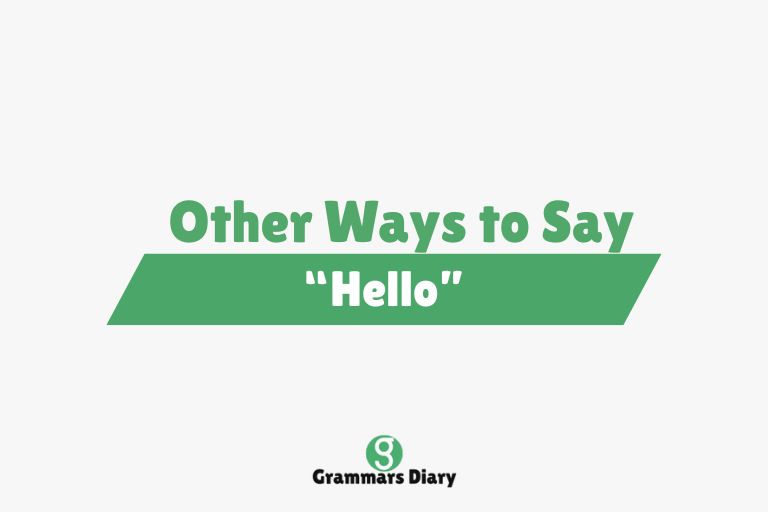“Hello” is the universal starting point of countless conversations, and whether we’re greeting someone in person, starting a phone call, or just sending a message, it’s a word we all use daily. But let’s face it — using the same word over and over again can feel repetitive, especially when we’re trying to make a memorable impression, spark joy, or simply bring a little personality into our interactions.
If you’ve ever found yourself reaching for a more original or expressive way to say “hello,” you’re not alone. Depending on your mood, the setting, or who you’re talking to, there are dozens of fun, casual, quirky, or even elegant alternatives to the traditional “hello.” This article explores 25 creative ways to say “hello,” providing context, examples, and guidance on when each variation might be most effective.
Whether you’re trying to break the ice, stand out in your emails, or just freshen up your daily language, the following greetings will give you a refreshing set of tools to brighten someone’s day and make your hellos a bit more engaging.
Other Ways to Say “Hello”
1. Hey There
Example: “Hey there! It’s been a while since we caught up.”
Meaning: A friendly and relaxed greeting that adds a personal and approachable touch, perfect for casual conversations.
Usage: Often used with friends or people you’re familiar with, especially when you want your tone to feel light and easygoing.
2. What’s Up?
Example: “What’s up? You look like you’ve got good news.”
Meaning: A conversational way to say “hello” while also inviting someone to share how they’re doing.
Usage: Best suited for informal settings, often used among friends, co-workers, or acquaintances you’re comfortable with.
3. Hiya
Example: “Hiya! How was your weekend?”
Meaning: A playful, energetic version of “hi,” typically associated with a cheerful attitude.
Usage: Common in the UK and perfect when you want to keep things upbeat and friendly.
4. Good Day
Example: “Good day to you, sir.”
Meaning: A polite and traditional greeting that can carry a sense of formality or old-fashioned charm.
Usage: Ideal for formal occasions, or when you want to add a touch of class or historical flair to your greeting.
5. Howdy
Example: “Howdy! You settling in alright?”
Meaning: A rustic, down-to-earth greeting that originated in the American South and West.
Usage: Great for casual, folksy environments or if you want to inject a bit of cowboy spirit into the conversation.
6. Greetings
Example: “Greetings! I’ve been looking forward to meeting you.”
Meaning: A neutral and polite alternative to “hello,” with a slightly formal or literary tone.
Usage: Suitable for emails, formal introductions, or situations where you want to sound courteous and well-mannered.
7. Yo
Example: “Yo! You ready for the game tonight?”
Meaning: A very casual, urban-style greeting that’s short and to the point.
Usage: Used primarily in relaxed settings, especially among younger crowds or close-knit groups.
8. Sup?
Example: “Sup? Everything going alright with work?”
Meaning: A shortened form of “What’s up?”, ultra-casual and often spoken rather than written.
Usage: Best kept for text messages or informal conversations between people who are on familiar terms.
9. Hello There
Example: “Hello there! Fancy meeting you here.”
Meaning: A slightly more charming and personalized take on “hello,” often used to express mild surprise or pleasure.
Usage: Friendly and versatile; works well in both casual and semi-formal settings.
10. Salutations
Example: “Salutations, my friend — always a pleasure.”
Meaning: A formal, intellectual-sounding greeting that adds a scholarly or eccentric vibe.
Usage: Often used humorously or in writing, especially when you want to sound witty or academic.
11. Yo Yo Yo
Example: “Yo yo yo! What’s going on?”
Meaning: A fun, emphatic version of “yo” used to energize a greeting and catch attention.
Usage: Great for informal group settings, especially among friends or social circles where playful banter is welcome.
12. Hey You
Example: “Hey you! I was just thinking about you.”
Meaning: A warm and slightly flirty greeting that feels affectionate and personal.
Usage: Often reserved for someone you know well, especially in one-on-one communication where emotional closeness is implied.
13. Hola
Example: “Hola! Long time no see.”
Meaning: The Spanish word for “hello,” widely recognized and often used for cultural flair or informal fun.
Usage: Works well when speaking with Spanish speakers or simply when you want to add an international touch.
14. Hi There, Stranger
Example: “Hi there, stranger — where have you been hiding?”
Meaning: A playful way to greet someone you haven’t seen in a while, hinting at missed interactions.
Usage: Perfect for reuniting with old friends or rekindling a conversation after some time apart.
15. Ahoy
Example: “Ahoy! Ready to set sail on this project?”
Meaning: A nautical-themed greeting that evokes images of pirates or sailors, often used for fun or dramatic flair.
Usage: Common in playful conversations or themed events, especially when you want to stand out or make someone smile.
16. G’day
Example: “G’day, mate! How’s everything going?”
Meaning: A casual Australian greeting equivalent to “good day.”
Usage: Great for international flavor, travel conversations, or simply when you want to add a laid-back vibe to your introduction.
17. Top of the Morning
Example: “Top of the morning to you!”
Meaning: A cheerful and somewhat old-fashioned Irish greeting used to wish someone a good start to the day.
Usage: Works well in the morning hours, especially in humorous, lighthearted exchanges or cultural references.
18. Hey There, Sunshine
Example: “Hey there, sunshine — you’re looking bright today.”
Meaning: A warm and affectionate greeting, often used to uplift someone’s mood or express fondness.
Usage: Suitable for close relationships, whether romantic or friendly, where emotional tone matters.
19. Peace
Example: “Peace, brother — glad to see you.”
Meaning: A casual and spiritual way of saying hello, often associated with the peace movement or calm, chilled-out personalities.
Usage: Typically used in informal circles that value mindfulness, relaxation, or spiritual openness.
20. Heya
Example: “Heya! You got a minute to talk?”
Meaning: An even more informal and bubbly version of “hey” or “hi.”
Usage: Perfect for quick greetings with people you know well, especially in texts or casual conversations.
21. Welcome Back
Example: “Welcome back! We missed having you around.”
Meaning: A greeting tailored for someone returning after a time away.
Usage: Used in both personal and professional contexts when acknowledging someone’s return with warmth.
22. Long Time No See
Example: “Long time no see! How have you been?”
Meaning: A common phrase used when greeting someone you haven’t seen in a while.
Usage: Friendly and nostalgic, perfect for rekindling past connections in both formal and informal settings.
23. How’s It Going?
Example: “How’s it going? You surviving the heat?”
Meaning: A conversational “hello” that also asks about the person’s wellbeing or day.
Usage: Frequently used in everyday interactions when you want your greeting to feel natural and caring.
24. What’s Crackin’?
Example: “What’s crackin’? You look like you’ve got big plans.”
Meaning: A highly informal and slangy way of asking “what’s going on?” while also greeting someone.
Usage: Best for casual and upbeat conversations with peers who enjoy playful language.
25. Hello, Beautiful
Example: “Hello, beautiful — just thought I’d say hi.”
Meaning: A flirty and endearing greeting that compliments the person as you say hello.
Usage: Use with someone you’re close to, especially in romantic or affectionate contexts, and only when appropriate.
When to Use Different “Hello” Alternatives
In Casual Conversations
When you’re talking to friends, family, or acquaintances in relaxed settings, informal greetings like “hey there,” “yo,” or “hiya” can help set a comfortable, friendly tone. These expressions work especially well in texts, group chats, or casual introductions where warmth and approachability matter more than formality.
In Professional or Formal Settings
In emails, meetings, or first-time introductions, it’s often best to stick with greetings that convey respect and courtesy, such as “greetings,” “good day,” or “hello there.” These options maintain professionalism while still giving you room to show personality if the tone allows.
In Creative Writing or Performance
If you’re writing dialogue, giving a speech, or performing on stage, you can use greetings like “ahoy,” “salutations,” or “top of the morning” to match a specific character, mood, or historical setting. These unique phrases can help you stand out and make your greeting more memorable and entertaining.
Conclusion
Saying “hello” doesn’t have to be boring or repetitive — it can be a small but powerful way to show personality, brighten someone’s day, or match the mood of the moment. From playful phrases like “yo yo yo” to polished alternatives like “greetings,” there’s a perfect greeting for every situation and social circle. Whether you’re sending an email, texting a friend, or starting a conversation in person, trying out one of these 25 creative ways to say “hello” can add a little extra charm to your communication.
For even more expressive language ideas and alternatives to common words and phrases, browsing trusted resources like Thesaurus.com can help expand your vocabulary and give you new ways to connect with others.
FAQs
What is a more creative way to say “hello”?
You can say “hey there,” “what’s up,” “ahoy,” or “hello, beautiful,” depending on the tone, context, and relationship with the person you’re greeting.
Is it okay to use informal greetings at work?
In casual office cultures, informal greetings like “hey” or “hi there” are often acceptable. However, in formal or traditional environments, it’s better to use greetings like “good morning” or “hello.”
Can greetings reflect your personality?
Absolutely. The way you say “hello” can convey friendliness, playfulness, formality, or creativity — helping others form a first impression based on your tone and language.
How can I make my greeting stand out?
Choose phrases that feel natural to you but are slightly less common, like “g’day,” “salutations,” or “hi there, stranger.” Adding energy, humor, or affection makes your greeting more memorable.











